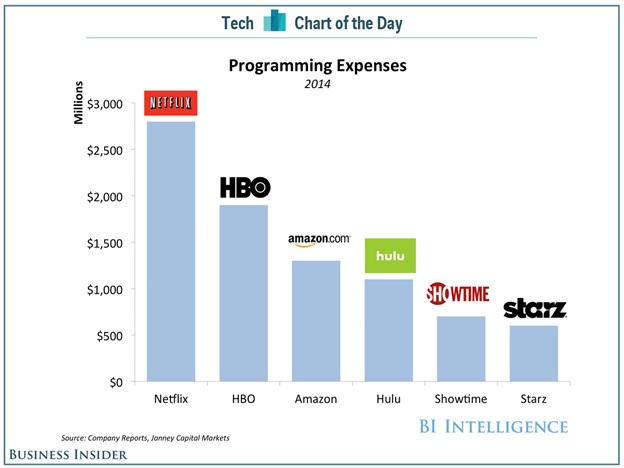It could be a drinking game at tech, radio, and automotive conferences. Any time someone says “Content is king,” down a shot. Or roll your eyes.
The truth of the matter is that content is, in fact, the most important thing. Take Netflix for example. They have disrupted the way we watch TV. As the chart below shows, 2014 showed a banner year in programming investment. Only ESPN was ahead of Netflix.
In 2015, the estimates are that Netflix spend upwards of $5 billion (with a B) on content, producing 16 original series. And for next year, Netflix has an even busier and more expensive pipeline: overall, 31 new scripted shows will be produced in 2016, more than double this year’s output.
But none of this would have been possible without a fantastic, innovative distribution model. When Netflix was the company that sent you DVDs through the mail in bright red pouches, they weren’t producing House of Cards and Orange Is The New Black. And they weren’t budgeting billions of dollars for programming content.
But thanks to their streaming engine and a fantastic interface, Netflix has not only changed the way we watch TV. They have changed the way that networks are able to create programming plans. In this way, distribution is actually driving content – at Mach 3.
Meantime, TV and cable networks simply leaned on their traditional models of disseminating their programming – through wires or the air, almost exclusively designing and scheduling their content in a real-time format.
There’s a message here for radio and it’s a simple one. The old delivery mechanism is still viable, of course. Towers and transmitters have proved to be reliable and scalable. (Pandora and Spotify only wish their models worked as well.)
But consumers are clearly looking for content in different places – websites, mobile apps, video, and streaming on-demand. Up to now, most radio companies and brands have provided limited content in these spaces, but more as an afterthought than as a main priority.
Part of that thinking has been driven by measurement, where only the terrestrial signal truly mattered. But consumers don’t care what’s rated and what’s not. They want content when and where they want it – period. And so while content is indeed king, distribution matters very much, too.
The news yesterday that Howard Stern re-signed with Sirius for five years was only part of the story. The “queen’s slipper” is a new video app featuring Stern content that is seen and not just heard. Clearly, SiriusXM is thinking about the entire royal family as they begin another five years with the “King of All Media.”
That’s the message that broadcast radio needs to get its head around. No one disagrees that the kingly part of the equation is of paramount importance. Testing your music, ensuring a quality audio processing chain, coaching key personalities, marketing the brand, and understanding the impact of the ratings on programming are all part of the machinations that programmers have undertaken for decades.
But today, crafting content for the queen piece of the pie may be even more important. Listeners take the terrestrial signal for granted. It’s always been there, a reliable and constant service that always works.
It’s the other elements that need attention – crafting content for the website, streaming, mobile applications, dashboards, and podcasts. And making sure the user experience on these outlets is as reliable as the tower and transmitter part is rapidly becoming table stakes.
As we approach the Christmas holiday, and even more smartphones, tablets, phablets, and wearables will end up under the tree and in stockings, the need for radio to be not just competitive in these spaces but to stand out, extend its brands, and keep long-time listeners elated. By the way, the auto industry is set to report all-time record sales for 2015. More than 18 million vehicles will be sold this year, and that means a lot more “connected cars” in driveways, car ports, and garages.
Distribution doesn’t just take care of itself. In fact, the last couple of decades suggest that radio operators would be wise to approach new outlets with greater investment, research, and innovation. It is a process that involves a better understanding of how consumers use these “queenly outlets,” as well as innovative ways to monetize them. Programmers who aren’t focused on new distribution outlets and sales managers who are clueless about how to market and sell them will find themselves continually frustrated as increasing number of users gravitate to new distribution devices and formats that are both convenient, accessible, fun, and satisfying.
At our mobile application company, jācapps, the mantra is “App Everywhere.” That means creating great mobile experiences for smartphones, smartwatches, smart TVs, and dashboards. These are all touch points that are fast becoming ubiquitous in our media lives. To become full-blown brands in 2016 and beyond, radio brands that matter will need to put a greater focus on distribution and monetization strategies.
The tower/transmitter model has served radio well for nearly a century. But eroding spot sales strongly suggest that a greater emphasis on both content and distribution in these wide open digital spaces isn’t just a good idea – it’s essential.
Long live the queen.
- How AI Can Give Radio Personalities More…PERSONALITY - April 23, 2025
- Can Radio Afford To Miss The Short Videos Boat? - April 22, 2025
- Media And Technology In 2025: Believe It Or Not! - April 18, 2025






Spot on! IF we cant be compelling, informative and entertaining, we shouldn’t do it. Content rules.
Thanks for the comment, Leslie.